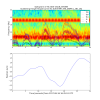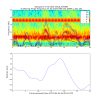TITLE: 06/16 Owl Shift: 07:00-15:00 UTC (00:00-08:00 PST), all times posted in UTC
STATE of H1: Observing at 60Mpc
INCOMING OPERATOR: Jeff
SHIFT SUMMARY:
Locking was dodgy. After a couple of failed attempts right at Noise Tunings and NLN, I got H1 locked but not wiothout some RF45 nastiness. It settled down after a while. A2L was looking pretty incoherent so I ran the script to put that back together to no positive effect on the noisy DARM spectrum. Handing off to Jeff B.
LOG:
7:41 1st attempt at locking failed at NLN!
7:45 adjusted X wrong fiber polarity from 15% to 11% (that's all I could get out of it)
8:59 Two failed attempts at NLN. Lock fails at Noise Tunings. Just got OMC DCPD saturation at DC readout but no lockloss.
9:28 Holding at LOWNOISE_ESD_ETMY there was heavy RF45 glitching. I don't know if it was because I was holding at this state?
9:33 Intention bit Unsiturbed. Had to accept a handful of SDF diffs.
10:30 Running a2l


































